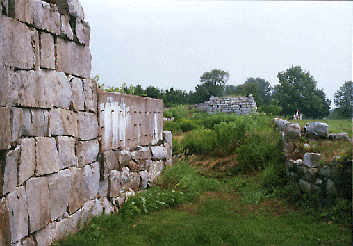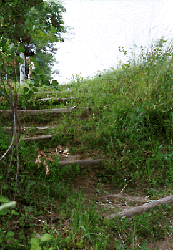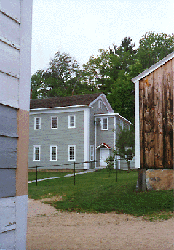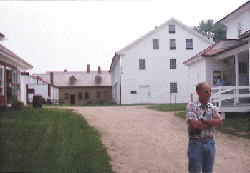The Old Spirit—
Is It Religious Community?
Shaker Village, Canterbury, New Hampshire.
Archaeological ruins of lost religious community are everywhere.
Barn foundations showing two periods of construction, stone and poured reinforced concrete.

The Shaker Village museum in Canterbury, New Hampshire, forty miles from Plymouth, symbolizes a lost community bound by religious faith. Mother Ann Lee, a Quaker, originated the sect of radical Quakers in England, but soon took her group to New York. Canterbury Shakers established their farming village in 1792, one of nineteen villages "Shaking Quakers" founded in the Eastern United States.
Steps from the herb garden.

The Tobey family were Quakers in the seventeenth century when they settled in Sandwich, Plymouth Colony, Massachusetts. Persecution by the established colonial church drove them from Sandwich. Some Tobey families settled in Maine (then a Massachusetts territory), where they purchased 10,000 acres and set up farming.
My last ancestors to practice the Quaker faith were my great great grandfather, Francis Tobey, and his Abenaki wife, Olive Cross. Francis originally worked as a seaman on a whaler out of New Bedford, but he moved to Maine to live and farm near his relations.
Olive Cross had relatives in Plymouth, New Hampshire, my home town. They moved to Plymouth in the late 1850s, beginning a century and a half of continuous residence in this New England village by my family. The last Tobey to live in Plymouth was Peter Gonnerman, son of my cousin, Mike Tobey Gonnerman, and his wife, Betsy. Peter pitched for the Plymouth State College baseball team.
The Shaker school, bell above the door.

Francis and Olive were not radical Quakers. Shakers practiced celibacy. Looking at the genealogical charts, it is obvious few Tobeys were celibate. Shakers increased their membership through conversion and adoption of children.
Carpenter's shop, firehouse, power house, creamery, and north shop.

Foreground—my college friend, Roger Amsden, a New Hampshire journalist.
In the 1850s, Canterbury village had a hundred buildings on 4000 acres with 300 residents. The last Shaker Sister at Canterbury died in 1992. Today, twenty-four buildings remain, in varying stages of restoration on 694 acres as a private museum.
Fence at Canterbury Shaker Village.

I am deeply moved by the Shaker Village, even though I have always been an atheist and a humanist. I am moved by my ancestors whose inner certainty of religious belief enabled them to endure horrendous persecution.
My parents insisted that I attend sunday school and services at the little Episcopal Church in Plymouth. My mother was Episcopal, my father was Congregationalist; so my church membership represented my mother's victory in a familiar family tug-of-war. I was a dutiful son. I was confirmed. I sang in the choir. I was an altar boy. I loved the theatre of the Mass. I loved the music of the High Anglican service—though I am tone deaf and have no singing voice at all. I loved reading from the Bible at the pulpit. I was told I had the voice of a minister. I was fascinated by theology. I respected the Canterbury Movement when I was a student at the University of New Hampshire.
Nonetheless, I never had any intellectual belief in a deity. I understand Ralph Waldo Emerson's consternation at the barrenness of spiritual life he felt, when he looked back on religious belief of past generations of New Englanders. I made the same choice as Emerson, to be an intellectual, in the New England sense.
Chesterton said, Christians go through their lives oblivious of God; but atheists go through life seeing Not-God everywhere. He was tweaking English Anglicans, but he pointed to the dilemma that haunts any intellectual who works out of New England's meaning. We must take Not-God seriously and not be beguiled by nostalgia—there is much spiritual work to be accomplished by humanists in our world.